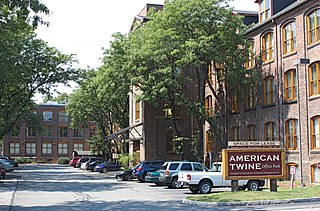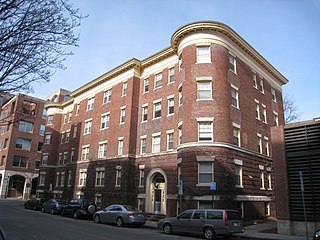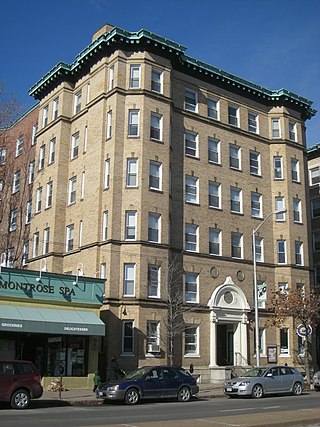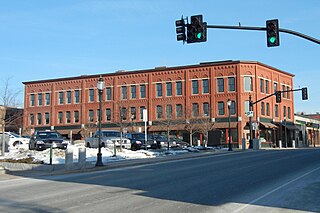
Harvard Yard, in Cambridge, Massachusetts, is the oldest part of the Harvard University campus, its historic center and modern crossroads. It contains most of the freshman dormitories, Harvard's most important libraries, Memorial Church, several classroom and departmental buildings, and the offices of senior University officials including the President of Harvard University.

Hamilton Hall is a National Historic Landmark at 9 Chestnut Street in Salem, Massachusetts. Designed by noted Salem builder Samuel McIntire and built in 1805–1807, it is an excellent instance of a public Federal style building. It was built as a social space for the leading families of Salem, and was named for Founding Father and Federalist Party leader Alexander Hamilton. It continues to function as a social hall today: it is used for events, private functions, weddings and is also home to a series of lectures that originated in 1944 by the Ladies Committee.

The Nathan and Mary (Polly) Johnson properties are a National Historic Landmark at 17–19 and 21 Seventh Street in New Bedford, Massachusetts. Originally the building consisted of two structures, one dating to the 1820s and an 1857 house joined with the older one shortly after construction. They have since been restored and now house the New Bedford Historical Society. The two properties are significant for their association with leading members of the abolitionist movement in Massachusetts, and as the only surviving residence in New Bedford of Frederick Douglass. Nathan and Polly Johnson were free African-Americans who are known to have sheltered escaped slaves using the Underground Railroad from 1822 on. Both were also successful in local business; Nathan as a caterer and Polly as a confectioner.

The American Net and Twine Company Factory is a historic factory at 155 2nd Street in Cambridge, Massachusetts. It was built in 1875 by the nation's first manufacturer of cotton fishing nets. It now houses corporate office space. It was listed on the National Register of Historic Places in 1982.

Athenæum Press is an historic building located at 215 First Street in Cambridge, Massachusetts. The structure occupies the entire block between First Street, Second Street, Athenæum Street, and Linskey Way, which was formerly known as Munroe Street. Topped by a statue of Athena sculpted by Adio diBiccari, the building is visible from the nearby Charles River and the Longfellow Bridge.

The James B. Barnes House is an historic house at 109 Hampshire Street, Cambridge, Massachusetts. Built in 1824 and moved to its present location in 1984, it is one of the only brick Federal-style houses left in Cambridge, and is a rare survivor of the early period of development in East Cambridge. It was listed on the National Register of Historic Places in 1982.

Bertram Hall at Radcliffe College is an historic dormitory building on the Radcliffe Quadrangle of Harvard University at 53 Shepard Street in Cambridge, Massachusetts. Built in 1901, it was the first dormitory building constructed for Radcliffe College. The building is now one of the dormitories of Harvard's Cabot House. It was listed on the National Register of Historic Places in 1986.

The Bigelow Street Historic District encompasses a uniform collection of 19th century houses on most of the length of Bigelow Street in Cambridge, Massachusetts, just northwest of Central Square. Bigelow Street was laid out in 1868, and the street was almost completely built out by 1874, resulting in a fairly uniform streetscape of Second Empire architecture. The district was added to the National Register of Historic Places in 1982.

Craigie Arms is a historic apartment house in Cambridge, Massachusetts. Located in Harvard Square, the Georgian Revival four-story brick building was built in 1897 to meet local demand for apartment-style housing. The building occupies most of a city block along University Road, Mount Auburn Street, and Bennett Street. It is notable for its relatively modest decoration and the rounded corner projections.

The Lovell Block is an historic residential and commercial building at 1853 Massachusetts Avenue in Cambridge, Massachusetts. The three-story brick building was built in 1882 by Andrew Jackson Lovell, with two specific commercial tenants in mind. One was his own grocery business, and the other was the North Cambridge Post Office. The upper floors contained a total of four well-appointed residential flats. The building was an early instance of a mixed-use residential-commercial structure, at a time when most lower-income housing was tenement-style, and the idea of higher-quality residential rental property was relatively new.

The Montrose is a historic multiunit residential building in Cambridge, Massachusetts. It is a six-story yellow brick building, whose Italian Renaissance details include a copper cornice with modillions, varied window treatments on each floor, belt courses of brickwork between some of the floors, and a front entry surround with fluted Doric columns. Built in 1898, it was one of the first "French flat" luxury apartment houses built in the city. The building was listed on the National Register of Historic Places in 1986.

Ware Hall is an historic residential apartment building at 383 Harvard Street in Cambridge, Massachusetts. It was designed by local architect George Fogerty and built in 1893. Fogerty was also the architect of Claverly Hall, a similar building, on Mount Auburn Street. This five story brick Classical Revival building is a rare example of an apartment house built in Mid Cambridge that was designed to cater to Harvard University students. Apartment blocks of this quality were generally built closer to the Harvard campus, so this one stands out when compared to other apartment house in its immediate surroundings.

Gillon Block is an historic commercial building at 189 Main Street in Milford, Massachusetts. The four story brick building was built in 1888 by Patrick Gillon, the owner of a bottle manufacturing company. It has a complex facade, divided into seven sections, with a central projecting section topped by a tower with a coppered onion dome. Matching sections at the center sections of the three on either side are articulated by piers and topped by gabled parapets. The building houses stores on the first floor and offices on the upper floors.

The Armory Block is a historic commercial building at 39-45 Park Street in Adams, Massachusetts. Built in 1894-95, it is a fine example of Renaissance Revival architecture, and one of the town's most architecturally sophisticated commercial buildings. It served as the local National Guard armory until 1914, and now houses commercial businesses. It was listed on the National Historic Register in 1982.

The Masonic Block is an historic commercial block in Reading, Massachusetts. This three-story brick building is distinctive in the town for its Renaissance Revival styling. It was built in 1894 by the local Reading Masonic Temple Corporation, and housed the local Masonic lodge on the third floor. The building was listed on the National Register of Historic Places in 1984.

The Armsby Block is an historic mixed-use residential and commercial building at 144-148 Main Street in Worcester, Massachusetts. Built in 1885 to a design by noted local architect Stephen Earle, it is a well-preserved example of Panel Brick architecture. The building was listed on the National Register of Historic Places in 1980.

The Item Building is a historic commercial building at 26 Albion Street in Wakefield, Massachusetts. Built in 1912, the single-story brick building serves as the headquarters of The Wakefield Daily Item, Wakefield's main community newspaper, and is a well-kept example of early 20th century commercial architecture.

The Alden-Delehanty Block is a historic commercial block at 858 Main Street in Southbridge, Massachusetts. Completed in 1888, it is the largest commercial building built in the town's Globe Village area, and is one of its most imposing Victorian edifices. The building was added to the National Register of Historic Places in 1989.

Colony's Block is a historic commercial building at 4-7 Central Square in the heart of Keene, New Hampshire. The five-story brick building was built in 1870 to a design by Worcester, Massachusetts, architects E. Boyden & Son, and is the city's most prominent example of Second Empire architecture. In addition to being a long-standing commercial center, the building housed the city library from 1870 to 1877. The building was listed on the National Register of Historic Places in 1983.
The John Winthrop Chambers, also known historically as the Brooks Apartments, is a historic apartment house at 78-80 Porter Road in Cambridge, Massachusetts. The building was listed on the National Register of Historic Places in 2023. Built in 1915, it is a significant local example of residential Colonial Revival architecture, and an early example of the large courtyard-style apartment block in the Porter Square neighborhood of Cambridge. It was listed on the National Register of Historic Places in 2023.






















